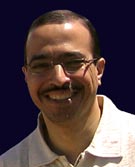RSNA Press Release
- Researchers may be close to finding an imaging technique that can identify thickening of the coronary artery wall, the earliest stage of coronary heart disease.
- Using a time-resolved multi-frame acquisition method, the success rate for obtaining a usable image was 90 percent versus a success rate of 76 percent for the single-frame method.
- In the future, MRI may be used to screen for individuals at risk for coronary artery disease without the use of ionizing radiation.
New MRI Technique Used to Identify Early-Stage Coronary Disease
Released: October 9, 2012
| Media Contacts: | |
| RSNA Media Relations: | 1-630-590-7762 |
| Linda Brooks 1-630-590-7738 lbrooks@rsna.org |
Maureen Morley 1-630-590-7754 mmorley@rsna.org |
OAK BROOK, Ill. — With the results of a magnetic resonance imaging (MRI) study from the National Institutes of Health (NIH), researchers say they are closer to finding an imaging technique that can identify thickening of the coronary artery wall, an early stage of coronary heart disease (CAD). The study is published online in the journal Radiology.
"Imaging the coronary arteries that supply the heart with blood is extremely difficult because they are very small and constantly in motion," said lead researcher Khaled Z. Abd-Elmoniem, Ph.D., staff scientist in the Biomedical and Metabolic Imaging branch of NIH's National Institute of Diabetes and Digestive and Kidney Diseases. "Obtaining a reliable and accurate image of these vessels is very important because thickening of the vessel wall is an early indicator of atherosclerosis."
CAD occurs when deposits of fat and cholesterol called plaques build up inside coronary arteries (a condition called atherosclerosis), increasing the risk of a heart attack and other coronary events. By identifying the vessel wall thickening that precedes artery narrowing, early intervention is possible.
"We currently have no reliable way to noninvasively image coronary artery disease in its early stages, when the disease can be treated with lifestyle changes and medications to lower cholesterol," Dr. Abd-Elmoniem said.
The researchers used MRI to measure the wall thickness of the coronary arteries in 26 patients with at least one risk factor for CAD and 12 healthy control participants matched to patients by body mass index (BMI). The mean age of the patients, which included 13 men and 13 women, was 48; healthy controls included three men and nine women (mean age 26).
To measure the coronary artery wall thickness in each of the study's participants, the researchers used both a single-frame MRI scan and an MRI technique called time-resolved multi-frame acquisition, in which five continuous images are captured in order to increase the success rate of obtaining an image free of blurring.
Using the time-resolved multi-frame acquisition method, the success rate for obtaining a usable image was 90 percent versus a success rate of 76 percent for the single-frame method.
Use of the time-resolved multi-frame technique also resulted in a greater ability to detect a significant difference between the wall thickness measurements of CAD patients and the healthy participants, as well as a smaller standard deviation, which is indicative of more precise measurements.
"These results suggest that MRI may be used in the future to screen for individuals at risk for coronary artery disease and may be useful for monitoring the effects of therapies," Dr. Abd-Elmoniem said.
"Dr. Abd-Elmoniem is a bright and inventive scientist who first suggested this innovative approach to improving coronary wall imaging," said Roderic Pettigrew, Ph.D., M.D., Director of the National Institute of Biomedical Imaging and Bioengineering (NIBIB) and senior collaborator of the study. "We are delighted that the technique is showing such practical promise."
Dr. Abd-Elmoniem said that unlike blood tests that measure cholesterol and lipids in the blood, which can be indicators of atherosclerosis, the thickness of coronary artery walls is a direct measurement of early-stage CAD. He said additional studies are needed to validate the time-resolved multi-frame MRI technique.
# # #
"Coronary Vessel Wall 3-T MR Imaging with Time-Resolved Acquisition of Phase-Sensitive Dual Inversion-Recovery (TRAPD) Technique: Initial Results in Patients with Risk Factors for Coronary Artery Disease." Collaborating with Drs. Abd-Elmoniem and Pettigrew was Ahmed M. Gharib, M.D.
Radiology is edited by Herbert Y. Kressel, M.D., Harvard Medical School, Boston, Mass., and owned and published by the Radiological Society of North America, Inc. (http://radiology.rsna.org/)
RSNA is an association of more than 50,000 radiologists, radiation oncologists, medical physicists and related scientists, promoting excellence in patient care and health care delivery through education, research and technologic innovation. The Society is based in Oak Brook, Ill. (RSNA.org)
For patient-friendly information on MRI, visit RadiologyInfo.org.

 PDF
PDF